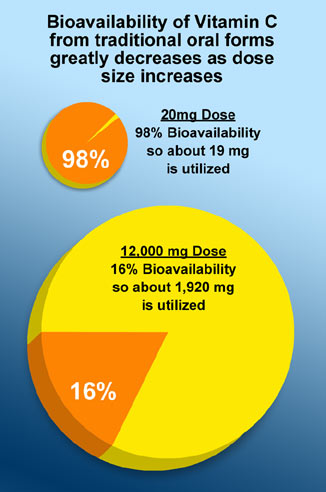The Life, Health Implications of LET Vitamin C
Cardiologist, Thomas Levy, MD JD, a frequent Vitamin C lecturer and the author of two books on the subject theorizes in his book, Curing the Incurable, that it is likely the human body was not intended to get all its ascorbate (Vitamin C) from dietary sources. He presents eight evidences for this theory:
- The need for ascorbate (Vitamin C) in the human body for basic maintenance of basic structure and function is essential and fluctuates greatly based on health status and environmental conditions.
- Even in IV doses exceeding 200 grams per day, no toxicity for ascorbate has ever been documented.
- Human livers have all the ingredients necessary to synthesize ascorbate except one — the enzyme L-Gulonolactone oxidase (GLO).
- Humans have the gene required to produce GLO but it is defective in the vast majority of the population.
- Some humans apparently synthesize ascorbate as not all individuals deprived of dietary ascorbate develop scurvy.
- Most mammals, reptiles, and amphibians do synthesize ascorbate. Some of the larger mammals produce upwards of 100 grams daily.
- Intravenous doses of ascorbate have shown powerful antioxidant, anti-toxin and anti-pathogenic properties in humans. (Dr. Levy cites many cases of this including Fred Klenner’s use of ascorbate to cure 60 out of 60 cases of polio in the late 1940s.)
- The uptake of ascorbate by the intestines is very inefficient.
 |
| Since Liposomal Encapsulation Technology can deliver virtually 100% of a nutrient directly to the bloodstream, it promises to eliminate the huge loss of bioavailability when dose sizes of actively transported nutrients are increased. This bio- availability chart was developed from a study done by J.L. Groff, S.S. Gropper, and S.M. Hunt which was published in the book Advanced Nutrition and Human Metabolism, West Publishing Co., 1995, pages 222-237. |
J.L. Groff (1995 - see chart at left) demonstrated that less than 2 grams of a 12 gram oral dose of Vitamin C actually gets to the bloodstream. Based on that study, 2 grams of liposomal encapsulated Vitamin C has the bio-availability equal to 24-500 mg tablets of the nutrient.

